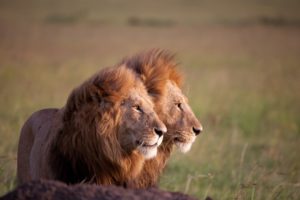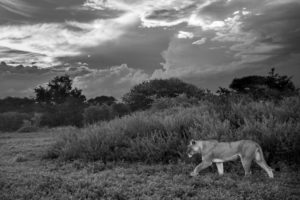Lions inhabit a parallel universe far older and wilder than ours, and for three years I was a privileged to enter their world, waking each morning to the sound of their thunderous voices and driving out into the bright Mara dawns to watch them hunting and observe their complex social behaviour.
That was in the late 1970s when I joined Jonathan Scott in Kenya to write The Marsh Lions, a true-life story built around the lions of Musiara Marsh in the Masai Mara National Reserve.
By the end of that time Scar and his pride were as familiar to me as old friends. Sometimes, parked alongside him as he lay in the grass, I would look at him and wonder: what is it like to be a lion? Surely the warmth of the sun on his tawny flanks must have felt as pleasing to him as it did to me? Sights, sounds and the ineluctable smells of the African bush, all these we shared. I watched him raise his head to sniff the breeze and listen to the zebra stallions calling to their mares on the open plains beyond; but what else went on behind that implacable visage would always remain a mystery.
Even before I first saw the Marsh Pride I had fallen under the spell of these charismatic carnivores. How could it have been otherwise, having had the good fortune to meet George Adamson of Born Free fame and the lions he was returning to the wilds of northern Kenya?
Since then, lions have continued to walk through my life and my dreams; but sadly not a year passes without their numbers continuing to decline. In 1980 more than 75,000 lions roamed across Africa. Today that number has shrunk to around 20,000 of which fewer than 3,000 are the territorial pride males every visitor most wants to see.
Those that remain have been reduced to living on only 8% of the land they once occupied. Yet even in their last strongholds they are at risk due to human-wildlife conflict, loss of prey species and an increasing illegal trade in lion parts. That is why Tusk is celebrating 2019 as our Year of the Lion, an initiative to shine a light on one of the world’s most charismatic animals and profile the work of some incredible conservation organisations working for a brighter future for the species.
One such organisation is the Ruaha Carnivore Project run by Dr Amy Dickman in Tanzania. “People are amazed that a species as iconic as the lion is under threat,” she says. “They think that just because everyone goes on safari and sees them they are stable – and they really are not.”
Ruaha National Park is home to 10% of Africa’s lions and the project was established in 2009 to reduce the conflict between its resident carnivores and the local Barabaig pastoralists living on its fringes. “Our 17 Lion Defenders and 15 conflict officers work hand in hand to mitigate human-carnivore problems across 17 villages,” she says, “and they are the first to respond whenever livestock is attacked by lions.”
Wherever lions exist they are a vital component of a healthy ecosystem – hence the creation of Lion Landscapes on Kenya’s Laikipia Plateau, an organisation dedicated to protecting the region’s predators through a programme of research and innovation.
Here, Tusk has supported their Collaring for Coexistence programme that gives livestock-owners access to the real-time movement date from collared lions. Armed with this knowledge they can keep their herds away from known lion locations, while the Lion Landscapes study is also able to keep tabs on the lions’ movements.
In 2019 Tusk funds will also support the Coexistence Co-op, an education, training and conflict management partnership between Lion Landscapes and the Peregrine Fund, designed to reduce human-predator conflict and stop the use of toxic pesticides that not only kill problem lions but also wipe out other carnivores and critically endangered vultures.
“Who will speak up for the lion when my own voice is carried away on the wind?” asked George Adamson. The answer is Tusk, and with your help we can continue to campaign for the survival of Africa’s most majestic big cats.








